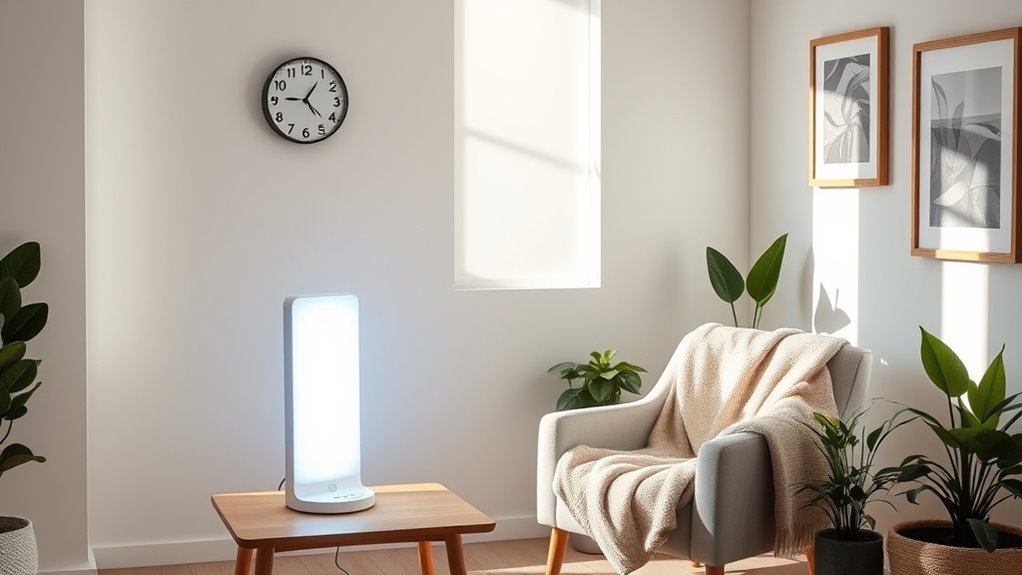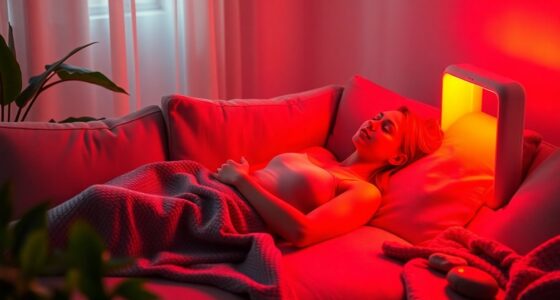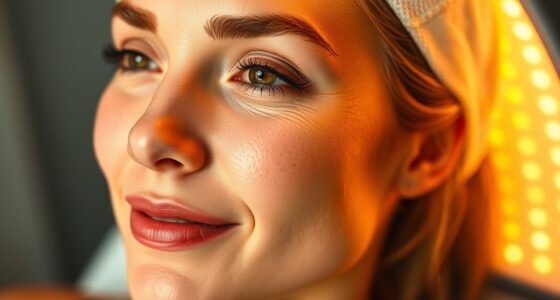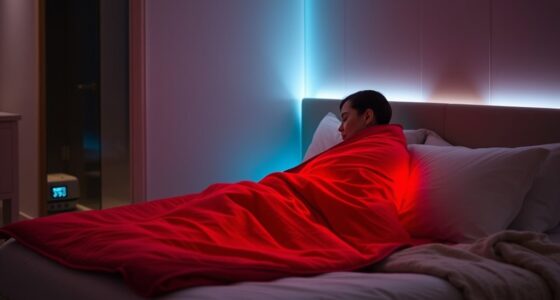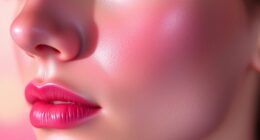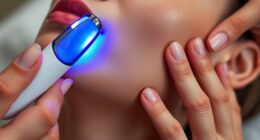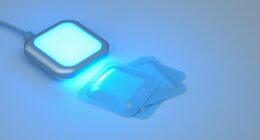Bright-light therapy is an effective way to manage seasonal depression, but it doesn’t have to be your only solution. Combining light therapy with natural strategies like mindfulness, dietary improvements, and outdoor activity can help reduce your reliance on a lamp. These approaches support your mood holistically and can enhance overall well-being. To discover how integrating these methods might work best for you, explore further tips that could brighten your darker months.
Key Takeaways
- Bright-light therapy is a proven, effective treatment for SAD, but it often works best as part of a comprehensive plan.
- Natural strategies like mindfulness and dietary changes can complement light therapy but may not fully replace it.
- Light therapy devices, including happy lamps, are designed to mimic natural sunlight and regulate circadian rhythms.
- Combining light therapy with lifestyle adjustments enhances mood stabilization during darker months.
- Personalized treatment plans, possibly incorporating AI tools, can optimize relief and reduce dependence solely on happy lamps.
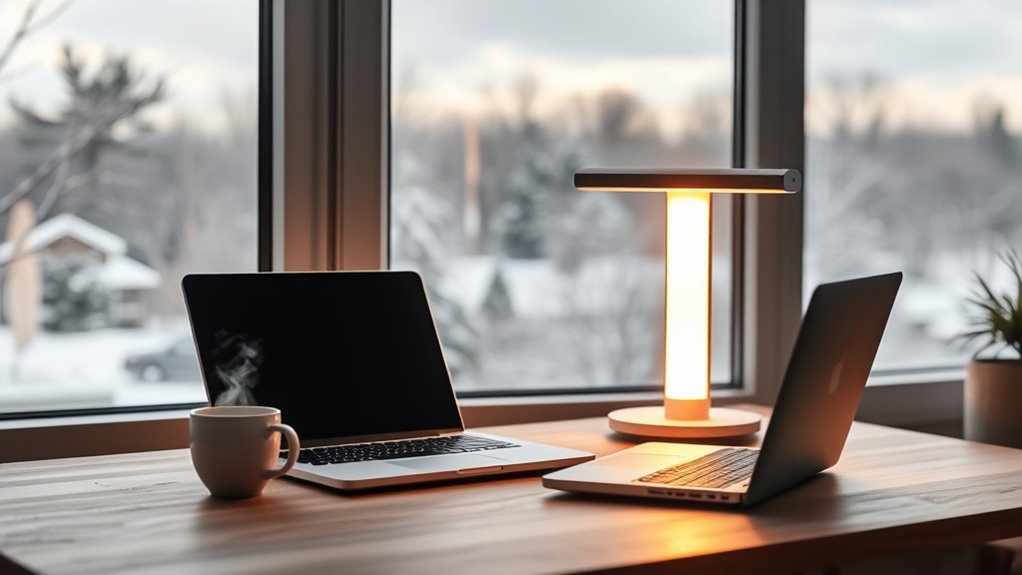
Are you feeling more tired, down, or unmotivated as the days get shorter? Seasonal depression, or seasonal affective disorder (SAD), can hit hard when daylight fades. While many turn to happy lamps or light therapy devices, it’s worth exploring other ways to boost your mood naturally. One effective approach involves incorporating mindfulness exercises into your daily routine. These practices, such as deep breathing, meditation, or mindful awareness, help you stay present and reduce feelings of anxiety or sadness. When practiced regularly, they can shift your focus away from negative thoughts and foster a sense of calm. Combining mindfulness with dietary adjustments can further enhance your resilience against seasonal blues. Eating foods rich in omega-3 fatty acids, vitamin D, and complex carbs supports brain health and stabilizes mood. For example, adding fatty fish like salmon, fortified cereals, nuts, and seeds to your diet can make a noticeable difference. It’s also beneficial to limit processed foods and sugar, which can lead to energy crashes and worsen feelings of depression. Additionally, understanding the role of AI in mental health can open up new avenues for personalized support and treatment options.
While bright-light therapy remains a popular and scientifically supported treatment, you might wonder if it can be replaced by other methods. Bright-light therapy mimics natural sunlight, helping regulate your circadian rhythm and boost serotonin levels, which are often low during darker months. However, many individuals find value in a holistic approach that combines light therapy with lifestyle changes. You don’t necessarily have to choose one over the other; instead, integrating mindfulness exercises and dietary adjustments can complement your use of a happy lamp. For instance, starting your day with a few minutes of mindful breathing or stretching can set a positive tone. Pairing this with a nutritious breakfast packed with mood-boosting ingredients creates a powerful routine. If you’re considering replacing or reducing your reliance on a happy lamp, give yourself time to see how your mood responds. Some people find that these natural strategies, alongside consistent outdoor activity when possible, help stabilize their mood without solely depending on light therapy. Remember, the key is consistency. Regular mindfulness exercises, healthy dietary choices, and exposure to natural light when you can, all work synergistically to combat seasonal depression. Ultimately, finding a personalized combination that fits your lifestyle can make the darker months more manageable and even uplifting.
Frequently Asked Questions
How Long Does It Take to See Results From Bright-Light Therapy?
When you start bright-light therapy, you might wonder about timing expectations for symptom improvement. Typically, you can expect to see noticeable results within one to two weeks of consistent daily use. However, individual responses vary, and some people may notice changes sooner or later. Stay patient and committed, as regular sessions often lead to better mood and energy levels, aligning with your overall treatment goals.
Are There Any Side Effects Associated With Bright-Light Therapy?
Imagine standing in a meadow at dawn, feeling the sun’s gentle warmth. Bright-light therapy can cause side effects like eye strain or sleep disruption if you don’t follow proper guidelines. You might experience headaches or eye discomfort, but these usually fade with adjusted exposure. To minimize risks, start with short sessions and avoid shining the light directly into your eyes. Consult a professional to guarantee safe, effective use.
Can Bright-Light Therapy Be Combined With Medication?
You can definitely combine bright-light therapy with medication, which often enhances overall treatment planning. This combination offers medication synergy, potentially boosting effectiveness for managing depression symptoms. Always consult your healthcare provider to guarantee proper integration and safety. When used together, bright-light therapy and medication can provide a more extensive approach, improving your mood and energy levels more effectively than either method alone.
Is Bright-Light Therapy Effective for All Types of Depression?
You might think bright-light therapy works like magic for all depression types, but that’s an exaggeration! It’s incredibly effective for Seasonal Affective Disorder, like sunlight in a box, but not a miracle cure for non-seasonal depression. You could try it, but it’s not a guaranteed fix for every mood swing. Always chat with a mental health pro to find the best treatment plan tailored just for you.
What Are the Best Times of Day to Use a Bright Lamp?
You should use a bright lamp in the morning to help regulate your circadian rhythm and boost mood. Incorporate it into your morning routines for the best results. Avoid evening exposure, as it can interfere with sleep. Using the lamp shortly after waking helps reset your internal clock, making your days brighter and more energetic. Consistency is key—aim for 20-30 minutes each morning for ideal benefits.
Conclusion
So, if you’re tired of feeling like a dull, gray cloud every winter, bright-light therapy might just be your shining superhero. It could turn your gloomy days into a vibrant rainbow, making you feel alive again. Don’t let seasonal depression drain the color from your life—try this powerful, natural remedy and reclaim your happiness. With consistent use, you might find it’s the brightest idea you’ve had all season, lighting up your world brighter than ever before.
